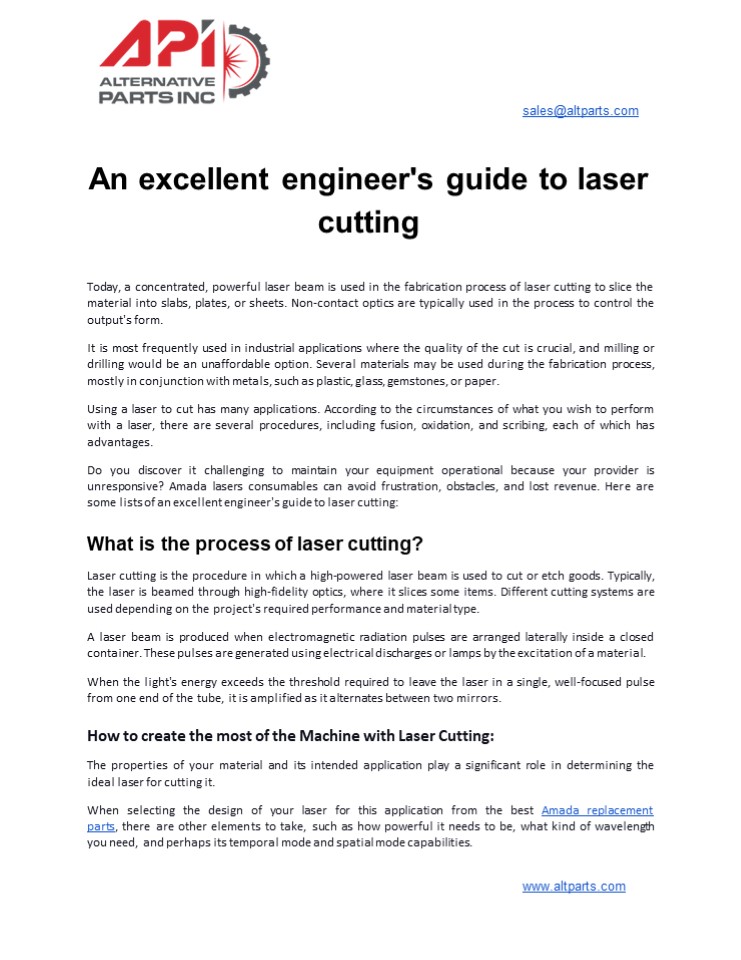An excellent engineer's guide to laser cutting - PowerPoint PPT Presentation
Title:
An excellent engineer's guide to laser cutting
Description:
An Engineer's excellent guide explains the processes, types, and benefits of laser cutting, An expert suggestion on selecting the finest laser cutter for you. – PowerPoint PPT presentation
Number of Views:1
Title: An excellent engineer's guide to laser cutting
1
An excellent engineer's guide to laser cutting
sales_at_altparts.com
- Today, a concentrated, powerful laser beam is
used in the fabrication process of laser cutting
to slice the material into slabs, plates, or
sheets. Non-contact optics are typically used in
the process to control the output's form. - It is most frequently used in industrial
applications where the quality of the cut is
crucial, and milling or drilling would be an
unaffordable option. Several materials may be
used during the fabrication process, mostly in
conjunction with metals, such as plastic, glass,
gemstones, or paper. - Using a laser to cut has many applications.
According to the circumstances of what you wish
to perform with a laser, there are several
procedures, including fusion, oxidation, and
scribing, each of which has advantages. - Do you discover it challenging to maintain your
equipment operational because your provider is
unresponsive? Amada lasers consumables can avoid
frustration, obstacles, and lost revenue. Here
are some lists of an excellent engineer's guide
to laser cutting - What is the process of laser cutting?
- Laser cutting is the procedure in which a
high-powered laser beam is used to cut or etch
goods. Typically, the laser is beamed through
high-fidelity optics, where it slices some items.
Different cutting systems are used depending on
the project's required performance and material
type. - A laser beam is produced when electromagnetic
radiation pulses are arranged laterally inside a
closed container. These pulses are generated
using electrical discharges or lamps by the
excitation of a material. - When the light's energy exceeds the threshold
required to leave the laser in a single,
well-focused pulse from one end of the tube, it
is amplified as it alternates between two
mirrors. - How to create the most of the Machine with Laser
Cutting - The properties of your material and its intended
application play a significant role in
determining the ideal laser for cutting it. - When selecting the design of your laser for this
application from the best Amada replacement
parts, there are other elements to take, such as
how powerful it needs to be, what kind of
wavelength you need, and perhaps its temporal
mode and spatial mode capabilities.
www.altparts.com
2
sales_at_altparts.com
- These factors can influence whether or not a
laser with an experienced focus or one that
offers different types of beam outputs will be
the better choice. - Wavelength
- The amount of heating required to melt or cut
through an object depends on the wavelength of
the laser beam because it affects how the
material absorbs light. - Beam Strength
- The size of the focusing spot a laser beam
produces and, consequently, the effectiveness of
the cut across a material are governed by its
modal distribution. A beam is typically thought
to be most effective when it produces Gaussian
data. - Focus Point
- The beam is assisted in focusing to a small,
highly concentrated point using a lens or a
specialized mirror. The focal spot, also known
as the focus, is where the beam's diameter is
most minor. - The optimum focus for your laser cutter depends
on a number of elements, such as the material's
qualities, thickness, beam's shape, mode, etc. - Power
- Getting stronger laser Amada replacement parts is
the best option if you cut many things. On the
other hand, you can get away with employing a
machine with a weaker laser if your applications
don't call for a lot of cutting. - Remember that greater intensity levels always
result in faster burning and more expensive each
cut. Again, flexibility is essential since it
depends on how much work needs to be done. - Types of laser cutting
- Fusion cutting provides a cutting edge almost
entirely free of oxide because it uses
reaction-inhibiting nitrogen or argon as the
cutting gas. - Utilizing oxygen as an aid gas during oxidative
cutting raises the temperature and reaction rate
at the cutting interface, allowing for the
quicker removal of thicker materials with a
lower-quality surface finish.
www.altparts.com
3
sales_at_altparts.com
- Benefits of using a laser cutting over other
cutting methods - Laser cutting has many advantages compared to
other cutting methods, including mechanical die
punching, sawing, plasma cutting, and waterjet.
The following list and analysis highlight some of
the main benefits - Reduced heat impacted zone and reduced material
deformation - Greater cutting accuracy
- High rates of repetition
- Less contamination of the materials
- Improved operational personnel safety conditions
- Better cutting edges and less additional
polishing needed after the cut - Decreased material waste because of improved
sheet use - Final Thoughts
- Finally, Innovative businesses can create new and
complicated products more rapidly and affordably
thanks to Amada laser consumables. Laser cutting
provides exceptional precision and
reproducibility and can produce parts in days
instead of weeks. - Source
- https//bestinbusiness.app/an-excellent-engineers-
guide-to-laser-cutt ing/
www.altparts.com






























![Future Strategic Issues/Future Warfare [Circa 2025] PowerPoint PPT Presentation](https://s3.amazonaws.com/images.powershow.com/7707537.th0.jpg?_=201603280611)
![Future Strategic Issues/Future Warfare [Circa 2025] PowerPoint PPT Presentation](https://s3.amazonaws.com/images.powershow.com/8666925.th0.jpg?_=20210513123)